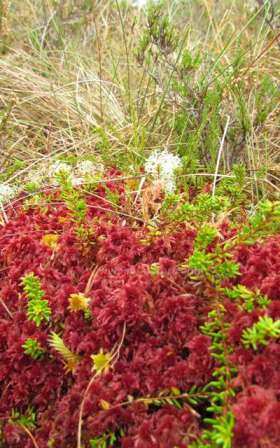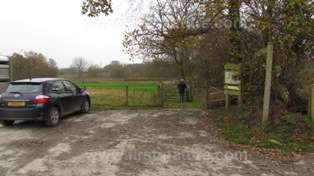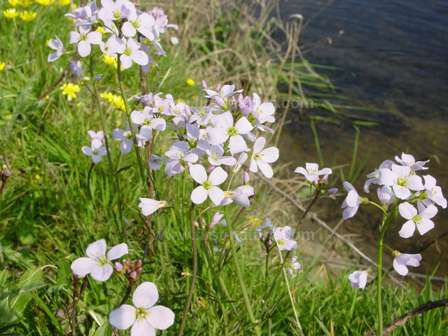Cors y Llyn National Nature Reserve, Nr. Newbridge on Wye, Powys, East Wales
Below: Winter colour at Cors y Llyn NNR

Designations: Geological and Biological SSSI
The term 'mire', which is used to describe the kind of habitat found at Cors y Llyn National Nature Reserve, hardly sounds like an invitation to the wild and beautiful place that you will discover on a visit there at any time of the year. Our first excursion was in late November, and although the surrounding countryside was definitely putting on its dreary winter clothing, the brightly coloured mosses and lichens in the NNR were enough to brighten up even the dullest of days.
The particular terrain found in the Reserve, which consists of two 'basins', was carved out of the underlying rock by glacial activity during the last Ice Age. As the glaciation came to an end around 12,000 years ago, the ice retreated; in doing so it ground out hollows that filled up with water and were then colonised by emergent plants. There are two such basins at Cors y Llyn, separated by a ridge of peat, and each has quite different biological qualities.
The reserve, which is managed by Natural Resources Wales (NRW), also has flower-rich meadow which is one of the best examples of this habitat in the area. More than 100 species of flowering plants have been recorded in this small area, and good flowers mean lots of butterflies on warm, still summer days.
Directions
Grid Ref: SO015553
The village of Newbridge on Wye lies on the A470 road midway between Rhyader and Builth Wells. If travelling from the north, you should drive through Newbridge on Wye and turn right onto the former A470 road immediately outside the village. This road now runs parallel with the new A470 road south towards Builth Wells.
Continue along this road for approximately 2.5km (1.5 miles) and look out for an unsigned right-hand turn (pictured below) with a cream cottage on the left hand side of the road (as you drive south). If approaching from Builth Wells there is a left turn off the new A470 road signed towards Cwm Bach Llechryd. This takes you onto the former A470 and the NNR is then a left hand turn opposite the cottage pictured below.
Turn into the narrow lane and continue along it about 400m (1/4 mile), passing through a farmyard, until you reach the end of the road. There you will find a parking area.
Below: Turn into the unmarked lane opposite this cottage
There is a signed, gated entrance to the NNR.

Access
The reserve is open all year round, and the access is excellent with paths that are level and easy. There is also a good board walk, which will easily accommodate wheelchair users, prams and pushchairs. Good waterproof shoes or boots are recommended for visits outside high summer, as water seeps up through the boardwalk during the autumn, winter and early spring months. Adders are regularly reported from this reserve (and many others), which is another good reason to wear stout shoes and always to keep your dog on a lead and under control. There are benches and seating in various parts of the reserve, accessible via the boardwalks, where you can sit and enjoy the wildlife around you.
Below: The car park and entrance to Cors y Llyn NNR

Facilities
There are no toilets at the reserve, the nearest public WC being in Newbridge on Wye. There is an information board at the entrance to Cors y Llyn. There are cafés, shops and pubs in nearby Newbridge on Wye and Builth Wells.
Description of Site
So-called Mires are both geologically and biologically important repositories of the environmental history of Wales. By investigating the pond sediment and the layers of plant detritus found there, we can discover evidence of the prehistoric vegetation that once grew in these places. Studies of the pollen found in mire deposits also provide a history of cultivated cereal plants that would have been grown in Neolithic times in this part of our countryside.
Below: The excellent boardwalk and seating right in the centre of Cors y Llyn NNR

History aside, a walk in this lovely nature reserve today is also an enlightening and enjoyable experience. This small area encapsulates such a variety of habitats and so many wonderful wildlife species that you leave feeling as if you seen in a couple of hours sights that most people somehow manage to miss in an entire lifetime! The wildflower meadow has an area of neutral grassland at its highest part and a wetter, more acidic area further down the slope. The combination of these two habitats creates opportunities not just for a greater variety of plants to thrive but also for a longer-than-average season. There are flowers in bloom here from early spring until really late in the season.
Below: One of Wales's earliest spring flowers, the Cuckoo Flower, blooms at Cors y Llyn NNR in March

One of the first flowers to come into its own in very early spring is the Cuckoo Flower (Cardamine pratensis). Although common and widespread, this humble member of the Cabbage family (Brassicaceae) creates wonderful pale-pink patches of colour in the meadow, letting us know that spring has arrived. This early ostentatious spectacle is followed by displays of a host of other flowers including the Heath Spotted-orchid (Dactylorhiza maculata), Dyer's Greenweed (Genista tinctoria), Marsh Violet (Viola palustris) and Meadow Thistle (Cirsium dissectum).
Lesser Skullcap (Scutellaria minor) is one of the less-common wildflowers to grow in the damper parts of the meadow, along with Lousewort (Pedicularis sylvatica) which is a semi-parasitic plant that takes some of its nutrients from the roots of other plants around it.
Later in the season the meadow still rewards insects by giving them a late top up of flower nectar, when Devil's-bit Scabious (Succisa pratensis), Common Knapweed (Centaurea nigra) and Sneezewort (Achillea ptarmica) come into their own.
Such a wealth of wildflowers means that the meadow at Cors y Llyn is also a great place to see butterflies. Wait for a warm, tranquil summer day and then Ringlets (Aphantopus hyperantus), Red Admirals (Vanessa atalanta), Small Tortoiseshells (Aglais urticae), Meadow Browns (Maniola jurtina), Green-veined Whites (Pieris napi) and Peacocks (Inachis io) - just some of the many butterfly species recorded from this site - may well put in an appearance.
Apart from the fabulous displays of mosses and lichens in the mire, there is also a very special flower - Marsh Cinquefoil (Comosum palustre) - which blooms from May until July. Rich deep, dark-red flowers with their complicated structure make this one of my favourites and a must-see-somewhere every year.
Below: The Broad-bodied Chaser - one of the many dragonflies that you are likely to see at Cors y Llyn NNR

The mire is home to amphibians, of course, and on the day that we visited the sound of Common Frogs croaking was everywhere. A quiet stroll may also mean catching a glimpse of them and their fellow residents, Common Toads and Palmate Newts. The Palmate Newt is the rarest of the three species of newts that are native to Britain; it has a less pronounced crest than the Great Crested Newt, but it is those distinctive webbed feet that are the origin of its common name and distinguish it immediately from other newt species.
Insect life is also abundant in and around the mire, and many dragonflies and jewel-coloured damselflies buzz about in summer. Some of the larger species of dragonflies include the Emperor, Broad-bodied Chaser, Southern Hawker and Common Hawker. Dragonflies are carniverous and feed on the vast numbers of tiny insects which thrive in such wet places, but in turn they become food for birds that live in the area, among which is a very special one, the Hobby, which can sometimes be seen hunting across the reserve.
Other birds that share the summer bonanza of tiny insects include visiting Swallows and House Martins, while in the winter visitors include Woodcock and Snipe.
This nature reserve, with its easy access and good paths, is truly a magical place to visit in spring, summer, autumn or winter. If you are in the area, make sure you don't miss it.